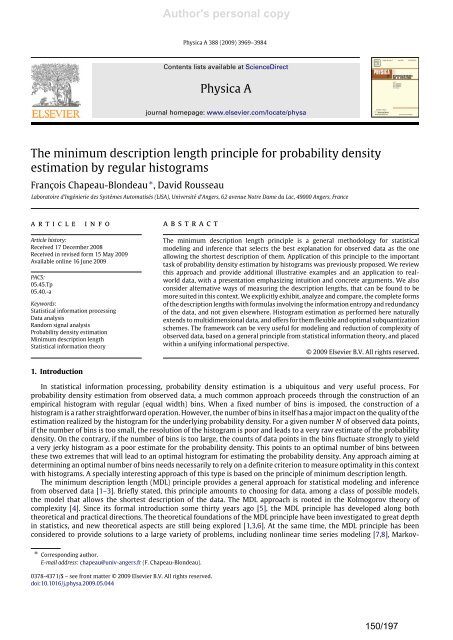a la physique de l'information - Lisa - Université d'Angers
a la physique de l'information - Lisa - Université d'Angers
a la physique de l'information - Lisa - Université d'Angers
Create successful ePaper yourself
Turn your PDF publications into a flip-book with our unique Google optimized e-Paper software.
Author's personal copy<br />
Physica A 388 (2009) 3969–3984<br />
Contents lists avai<strong>la</strong>ble at ScienceDirect<br />
Physica A<br />
journal homepage: www.elsevier.com/locate/physa<br />
The minimum <strong>de</strong>scription length principle for probability <strong>de</strong>nsity<br />
estimation by regu<strong>la</strong>r histograms<br />
François Chapeau-Blon<strong>de</strong>au ∗ , David Rousseau<br />
Laboratoire d’Ingénierie <strong>de</strong>s Systèmes Automatisés (LISA), <strong>Université</strong> d’Angers, 62 avenue Notre Dame du Lac, 49000 Angers, France<br />
a r t i c l e i n f o<br />
Article history:<br />
Received 17 December 2008<br />
Received in revised form 15 May 2009<br />
Avai<strong>la</strong>ble online 16 June 2009<br />
PACS:<br />
05.45.Tp<br />
05.40.-a<br />
Keywords:<br />
Statistical information processing<br />
Data analysis<br />
Random signal analysis<br />
Probability <strong>de</strong>nsity estimation<br />
Minimum <strong>de</strong>scription length<br />
Statistical information theory<br />
1. Introduction<br />
a b s t r a c t<br />
The minimum <strong>de</strong>scription length principle is a general methodology for statistical<br />
mo<strong>de</strong>ling and inference that selects the best exp<strong>la</strong>nation for observed data as the one<br />
allowing the shortest <strong>de</strong>scription of them. Application of this principle to the important<br />
task of probability <strong>de</strong>nsity estimation by histograms was previously proposed. We review<br />
this approach and provi<strong>de</strong> additional illustrative examples and an application to realworld<br />
data, with a presentation emphasizing intuition and concrete arguments. We also<br />
consi<strong>de</strong>r alternative ways of measuring the <strong>de</strong>scription lengths, that can be found to be<br />
more suited in this context. We explicitly exhibit, analyze and compare, the complete forms<br />
of the <strong>de</strong>scription lengths with formu<strong>la</strong>s involving the information entropy and redundancy<br />
of the data, and not given elsewhere. Histogram estimation as performed here naturally<br />
extends to multidimensional data, and offers for them flexible and optimal subquantization<br />
schemes. The framework can be very useful for mo<strong>de</strong>ling and reduction of complexity of<br />
observed data, based on a general principle from statistical information theory, and p<strong>la</strong>ced<br />
within a unifying informational perspective.<br />
© 2009 Elsevier B.V. All rights reserved.<br />
In statistical information processing, probability <strong>de</strong>nsity estimation is a ubiquitous and very useful process. For<br />
probability <strong>de</strong>nsity estimation from observed data, a much common approach proceeds through the construction of an<br />
empirical histogram with regu<strong>la</strong>r (equal width) bins. When a fixed number of bins is imposed, the construction of a<br />
histogram is a rather straightforward operation. However, the number of bins in itself has a major impact on the quality of the<br />
estimation realized by the histogram for the un<strong>de</strong>rlying probability <strong>de</strong>nsity. For a given number N of observed data points,<br />
if the number of bins is too small, the resolution of the histogram is poor and leads to a very raw estimate of the probability<br />
<strong>de</strong>nsity. On the contrary, if the number of bins is too <strong>la</strong>rge, the counts of data points in the bins fluctuate strongly to yield<br />
a very jerky histogram as a poor estimate for the probability <strong>de</strong>nsity. This points to an optimal number of bins between<br />
these two extremes that will lead to an optimal histogram for estimating the probability <strong>de</strong>nsity. Any approach aiming at<br />
<strong>de</strong>termining an optimal number of bins needs necessarily to rely on a <strong>de</strong>finite criterion to measure optimality in this context<br />
with histograms. A specially interesting approach of this type is based on the principle of minimum <strong>de</strong>scription length.<br />
The minimum <strong>de</strong>scription length (MDL) principle provi<strong>de</strong>s a general approach for statistical mo<strong>de</strong>ling and inference<br />
from observed data [1–3]. Briefly stated, this principle amounts to choosing for data, among a c<strong>la</strong>ss of possible mo<strong>de</strong>ls,<br />
the mo<strong>de</strong>l that allows the shortest <strong>de</strong>scription of the data. The MDL approach is rooted in the Kolmogorov theory of<br />
complexity [4]. Since its formal introduction some thirty years ago [5], the MDL principle has <strong>de</strong>veloped along both<br />
theoretical and practical directions. The theoretical foundations of the MDL principle have been investigated to great <strong>de</strong>pth<br />
in statistics, and new theoretical aspects are still being explored [1,3,6]. At the same time, the MDL principle has been<br />
consi<strong>de</strong>red to provi<strong>de</strong> solutions to a <strong>la</strong>rge variety of problems, including nonlinear time series mo<strong>de</strong>ling [7,8], Markov-<br />
∗ Corresponding author.<br />
E-mail address: chapeau@univ-angers.fr (F. Chapeau-Blon<strong>de</strong>au).<br />
0378-4371/$ – see front matter © 2009 Elsevier B.V. All rights reserved.<br />
doi:10.1016/j.physa.2009.05.044<br />
150/197


